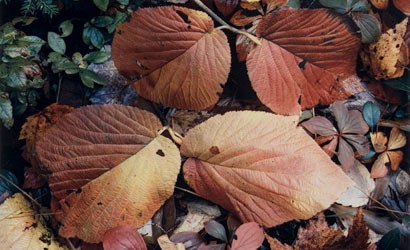Influential Nature Photographers Featured in New Exhibition
"Regarding the Land: Robert Glenn Ketchum and the Legacy of Eliot Porter," at the Amon Carter Museum, Fort Worth, Texas, Sept. 16 through Jan. 7, 2007.

Ask most nature photographers to name their important influences and Eliot Porter is usually at the top of the list, nosing out odds-on favorite Ansel Adams. And this makes sense: The work being done by today’s nature and landscape photographers generally looks much more like Porter’s than Adams’s. It’s not only that it is in color–Porter having pioneered the use of color in nature photography in the 1950s and 1960s–as opposed to Adams’s austere black and white. It is also that in contrast to Adams’s typically grandiose, deep-focus take on the great outdoors, Porter often concentrated on the middle distances at which Adams seemed almost uncomfortable.
While Porter would be satisfied with the frame-filling monochrome of a moss-covered log, for Adams that log was better used as a foreground prop to create a sense of depth. Indeed, some of Porter’s best images have a remarkable flatness–the tipping up of the picture plane so loved by modern art’s critics–that was ahead of its time in the descriptive world of color photography. I remember being amazed by the cover image of Porter’s 1962 Sierra Club book, In Wildness is the Preservation of the World: It was less about leaves floating on water than it was about the modulation of reflected light from blue at the bottom of the frame to orange at the top, an effect more painterly than photographic. Disseminated mainly through such books, Porter’s work managed to be art while advancing America’s consciousness of nature’s needs–and fomenting the environmental movement of the 1960s.
Perhaps more than any other contemporary photographer, Robert Glenn Ketchum has picked up where Eliot Porter left off. The connection between these two important artists is the subject of “Regarding the Land: Robert Glenn Ketchum and the Legacy of Eliot Porter,” an exhibition opening this Sept. 16 at the Amon Carter museum in Fort Worth, Texas and continuing through January 7, 2007.
Porter was the brother of realist painter Fairfield Porter, who introduced his sibling early on to Alfred Steiglitz; Steiglitz showed Eliot’s black-and-white landscapes at his famous gallery, An American Place, in 1938. But the photographer’s training was in the biomedical sciences, and that background certainly influenced his work, especially the photographs of birds he made throughout his life. Ketchum took a more artistic path from the start, studying with Robert Heinecken at UCLA in the late 1960s and going on to produce color images in which the natural world was flattened even more than Porter dared. In that early work, the busy detail of nature dissolves into an abstraction that seems to cross-pollinate field painter Jules Olitski with action painter Jackson Pollock. “Porter was at heart a scientist, albeit one with a remarkably imaginative and poetic eye,” says John Rohrbach, the Amon Carter museum’s senior curator of photographs. “Ketchum, on the other hand, is at his core an artist. His photographs do not merely describe the world but are also tools for exploring how we see it.”
I’d only beg to differ that Porter’s work was merely descriptive. It is too often highly selective in its framing and spare in its content for that.
But for both artists, photographs were and are a tool for promoting an environmental agenda. Porter went on from In Wildness to produce five more large-format books for the Sierra Club on subjects such as Utah’s Glen Canyon (his contribution to a failed effort to stop the building of a dam that flooded the canyon), publications that did much to give the club the political clout it now possesses. Likewise, Ketchum’s numerous books for Aperture have often been paired with campaigns orchestrated by the photographer to influence national environmental policy and legislation.
That agenda, together with a more modern, omnivorous photographic sensibility, has led Ketchum to produce images of environmental depredation along with views of the pristine wilderness he seeks to preserve. It’s a measure of how far we’ve come, photographically if not in our environmental consciousness, that it would not have occurred to Eliot Porter to make such pictures.